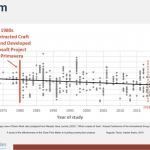(Hal Macomber, EVP, Touchplan with Terri Erickson, Principal, Kata Consulting
The productivity of the design and construction industry has been slowly decreasing for over 40 years while productivity in other industries has soared. This is in spite of the countless innovations to materials, tooling, and equipment. Consequently, construction in many sectors, particularly infrastructure and housing, is unaffordable. Nearly 30 years ago, many of us thought adopting Lean would bend the curve to a steady incline. We misunderstood our situation.
In 1990 with the publishing of The Machine that Changed the World, the word lean was first used to characterize Toyota’s approach to designing and building their cars. It merely meant there was no fat in their system. Unfortunately, it was a misunderstanding of the real nature of Toyota’s approach. The misunderstanding continued when The Toyota Way was published in 2003. Jeffrey Liker claimed, “the heart of the Toyota Production System is eliminating waste,” although he did go on to write about growing leaders and growing exceptional people.
We now know that Toyota’s key principle is to grow people’s capabilities through engagement with the work. Toyota’s system is designed and evolved for the purpose of everybody-everyday-always learning. That learning is responsible for Toyota’s unparalleled success as compared to virtually every other automotive manufacturer. This learning is what has been missing from Lean design and construction efforts.
My 2010 Guidance on Putting “Tightly Couple Learning with Action” to Work
Toyota’s goal is single-piece flow at the signal of the customer. But why is it so important to do just one at a time? The answer is we want to learn from each action we take. Toyota sees it as the opportunity to test and re-test their hypothesis of how to do work effectively. The approach is generally known as the Deming Cycle: Plan – Do – Study – Act. Here are six ways you can begin adopting the principle “tightly couple learning with action” on your projects:
- Meet at the end of each day for just 5 minutes with the last planners (or frontline workers) on your project to give them the opportunity to report on the work they finished for the day as they had promised to do. Identify at that time any reasons for not finishing promised work. Re-plan as necessary.
- Do detailed planning for short horizons (6 weeks or less). Review the outcome, then do more detailed planning.
- Conduct a plus-delta review at the end of each planning meeting. Ask all attendees, (plus) “What produced value for you?” and (delta), “What could we change to produce more value for you?” Start the next meeting by referring back to the last review. Select one item from that list for focus during the meeting.
- Conduct a Good 5-Why™ for something that needs to be reworked, repaired or replaced. Getting to the root causes of why something occurred will lead to actions you can take to avoid recurrence of the variance or problem. (See No-Fault Problem Solving)
- Have a conversation with the whole team on something that needs improvement. Take action based on an 80% complete solution. Try it out. Review the results. Then create an 80% solution for the balance of the issue.
- Attack the delays on your project. Explore with your team what keeps them from more closely coupling one person’s work with another person’s work. Do an experiment. Learn. Re-do the experiment.
Put these to work on your project immediately. Start by discussing this with your team. You might want to create a contest with them to see who can generate the most ways for coupling learning with action.
Our New Guidance: Change Your System to Put Learning at the Center
Nearly 30 years ago, the learning organization was seen as the way the best organizations would function. Jeff Liker mentioned it in the first edition of The Toyota Way. In the second edition, he put learning at the center of what distinguishes Toyota from others. Learning – building capability at individual, group, and company levels – principally happens in action. It’s as true for learning to play the guitar as it is for doing the calcs to size a beam or for leading organizational change. Yet, too often we understand learning as what happens when taking a course, attending a webinar, or watching a Ted talk. These activities take us away from the everyday work where we are in action. Toyota doesn’t make this mistake. They use everyday work as the primary setting for building capability.
The above six earlier recommendations from Putting the Five Big Ideas to Work mostly focuses on after-action steps you can take to learn. What I missed was what you can do to learn while in action. I’m reminded about two situations. A few years ago my friend and coauthor Calayde Davey of The Pocket Sensei – Mastering Lean Leadership took gigs to play Christmas music. The music was very familiar to her. She might have been bored. Instead, Calayde made playing that music the opportunity to practice very specific violin skills. In the other situation, I challenged a summer engineering intern to get the most from the experience. I said, “When you get an assignment ask ‘what do you want me to learn while I do this?’” This is the central question each of us can ask as we begin to do whatever it is we are doing. The shift to make is to turn the work into purposeful practice. Use tasks to add or refine a skill.
The organization or project team can create the circumstances each assignment is the opportunity to practice what each person or a small group needs for growing skill or capability. It can be as simple as asking, “What is it I will practice while performing the task?” and “How will I know that I got better, or not?” Sometimes we need an observer to distinguish between doing something effectively and not effectively. Other times, self-reflection will suffice. Couple this practice with the widely used G.R.O.W. coaching approach adopted by Google and the workgroup or company will build the capability that the business or project needs.
We have to mention Toyota Kata (TK) as a significant opportunity to develop critical and creative thinking skills for individuals and groups while pursuing workgroup and company goals. It was developed by Mike Rother while studying Toyota. The approach starts with a challenge – something beyond the reach of the team. People perform experiments (for the sake of learning) in the course of doing their work to advance their way toward the challenge. Learning is consolidated as improvements to the process or product. Customers, the company, and the team members all benefit as challenges are achieved and capabilities accumulate. Check out the growing community of people practicing TK at KataCon7.
The key theme throughout our guidance for putting this big idea to work is to change your system and practices to use your everyday work to grow people on projects and throughout the organization.
If you missed last week’s installment please be sure to read Collaborate, Really Collaborate
For more information on Lean Planning & Best Practice please read 4 Tips for a Zero-Punch-List-Project
If you would like to see how Lean construction delivered a hospital renovation well ahead of schedule, read our case study about Touchplan being used by Granger Construction.
If you would like to revisit any of the posts from the Revisiting the Five Big Ideas series you can find all of them below.
- Part 1: Transforming the Design and Construction Industry
- Part 2: Collaborate; Really Collaborate
- Part 3: Tightly Couple Learning with Action
- Part 4: Optimize the Project as a Whole
- Part 5: Conduct Construction Projects as a Network of Commitments
- Part 6: Bring an Outward Mindset to All Interactions
- Part 7: Project Production Thinking Behind the Five Big
- Part 8: Pursue Project Outcomes at the Intersection of the Five Big Ideas
- Part 9: Adopting the Five Big Ideas on Your CM/GC Projects
- Part 10: What Comes After The Five Big Ideas?










